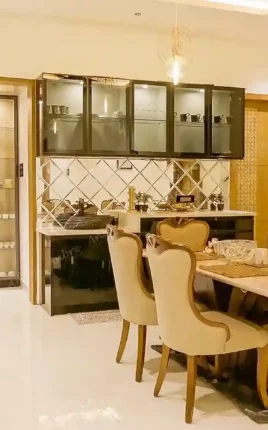Island Kitchen Design
The kitchen island is essential in modern home design, combining style and functionality. With various design options, it can be tailored to your aesthetic. Key features include the island chimney for cleanliness and ample storage. Discover our collection for cabinets, shelves, and backsplashes to enhance your island kitchen.
Optimize Space Efficiency With Island Kitchen Designs
Here are several creative kitchen island ideas that can improve your cooking area, including small kitchen island concepts, compact kitchen islands, and space-saving kitchen solutions from Anbre Interiors
Large Island with White Counter Top
Moody theme Island kitchen Design
Blue and wood Island Kitchen Design
Skyblue Island Kitchen
Island Kitchen in white grey
Modern Island Kitchen
Best Island Kitchen Design Ideas
Contemporary Island Kitchen Design
Trending Island Kitchen Design
Benefits of a Island Kitchen Designs
Efficient Workflow: The U-shaped layout ensures a smooth flow between the stove, sink, and refrigerator, enhancing kitchen efficiency.
Maximized Storage: With cabinets and countertops on three sides, this layout offers ample storage and workspace, ideal for busy kitchens.
Modern & Functional: The seamless design combines practicality with a contemporary aesthetic, making it perfect for any home
Do you have a specific layout in mind for your modular kitchen?
FAQs About kitchen island designs
An island kitchen layout is popular for its many uses and attractive look. The central island adds extra workspace, storage, and seating, making it the kitchen’s main area.
It improves the kitchen’s function by providing more counter space for preparing food, cooking, and serving. Islands can also hold appliances like sinks, cooktops, or dishwashers, which helps the kitchen flow better.
Additionally, an island can be a social spot where family and friends gather, making the kitchen more inviting. The island’s flexibility allows it to be used for casual dining, homework, entertaining, and cooking.
The space needed for an island kitchen depends on the room’s size and layout. Ideally, you should have at least 12 by 12 feet of space for a comfortable island. This allows enough room to move around and access appliances and cabinets easily.
It is best to have 36 to 48 inches of space on all sides of the island. This helps avoid crowding and keeps traffic flowing smoothly.
When planning an island kitchen, think about the overall layout and the island’s size. This will help ensure the island improves the kitchen’s function instead of making it harder to use.
– Kitchen islands can be customized for both small and large kitchens with varying designs and functions.
– Small kitchens benefit from compact islands or rolling carts for workspace and storage without crowding.
– Large kitchens can feature substantial islands with extensive counter space, storage, and seating options.
– Larger islands may include sinks, cooktops, and built-in appliances for enhanced functionality and aesthetics.
– Efficient island kitchen storage includes base cabinets for pots, pans, and utensils.
– Organizers in drawers keep cutlery and tools neatly arranged.
– Use pull-out shelves, lazy Susans, and deep drawers for optimal space utilization.
– Integrate appliances like microwaves or wine fridges to enhance overall storage capacity.
– Proper lighting enhances the island’s functionality and visual appeal using a layered approach of task, ambient, and accent lighting.
– Pendant lights offer focused task lighting and decorative elements, hung 30-36 inches above the island.
– Under-cabinet and recessed lights provide additional task lighting for food preparation.
– Accent lighting, like LED strips, highlights the island’s design features and adds a modern touch.
– Adding seating to an island kitchen enhances functionality and creates a casual dining area.
– An overhang of at least 12 inches provides comfortable legroom for bar stools or chairs.
– Allocate 24 to 30 inches of space per seat for comfort; choose design-complementing, movable seating.
– Larger islands can include built-in benches or dedicated seating for family gatherings and entertaining.
– Kitchen island countertop materials include granite, quartz, marble, butcher block, and stainless steel.
– Granite and quartz are durable, scratch-resistant, and ideal for busy kitchens.
– Marble offers luxury but requires more maintenance due to its porous nature.
– Consider durability, maintenance, cost, and design compatibility when selecting a countertop material.
– Incorporating appliances in a kitchen island enhances functionality and workflow efficiency.
– Popular appliances include sinks, cooktops, dishwashers, microwaves, and wine coolers.
– Ensure plumbing, electrical, and ventilation connections are available for the appliances.
– Maintain adequate counter space for food preparation and seating while integrating appliances.
– Use contrasting countertop materials or colors to make the island a focal point in the kitchen.
– Add open shelving or glass-front cabinets for display space and easy access to kitchenware.
– Enhance functionality with features like a prep sink, second dishwasher, or built-in wine rack.
– Personalize the island with custom hardware, unique lighting, and decorative accents to reflect your style.
– Plan island kitchen layout using the work triangle for optimal workflow and efficiency.
– Position sink, stove, and refrigerator in a triangular arrangement to minimize movement.
– Ensure sufficient clearance around the island for easy access to appliances and cabinets.
– Incorporate smart storage and adequate lighting to enhance functionality and workflow.
100+ Great Island Kitchen Ideas for Your Space
Designing a kitchen that is both functional and stylish can be a challenging task. However, incorporating a kitchen island into your design can transform your space into a practical and beautiful area. Whether you have a small kitchen or a spacious one, an island kitchen design can offer numerous benefits. Here are over 100 amazing island kitchen design ideas that can inspire your next renovation project.
Benefits of an Island Kitchen Design
An island kitchen design provides several advantages. It increases your countertop space, offers additional storage, and can serve as a focal point for your kitchen. Moreover, it provides a space for casual dining and entertaining guests. Islands can also house appliances, sinks, and even built-in cooktops, making them a versatile addition to any kitchen.
Space Planning for Small Kitchen design with Island
When dealing with a small kitchen, space planning is crucial. Opt for a compact kitchen island that does not overwhelm the space. A narrow island with built-in storage can keep your kitchen organized without taking up too much room. Consider using materials that reflect light, such as glossy finishes or glass, to create an illusion of a larger space.
Modular Kitchen Design with Island
Modular kitchens are designed for efficiency and flexibility. Incorporating an island into a modular kitchen design can enhance its functionality. Choose modular units that can be customized to fit your specific needs, whether it’s additional storage, a wine rack, or an integrated breakfast bar. Modular islands can be easily reconfigured, making them a practical choice for dynamic kitchen spaces.
Kitchen Island Design Ideas
- Rustic Charm: A wooden island with a distressed finish can add a rustic touch to your kitchen. Pair it with vintage stools for a cozy, farmhouse feel.
- Modern Minimalism: Opt for a sleek, minimalist island with clean lines and a monochromatic color scheme. This design works well in contemporary kitchens.
- Bold and Bright: Make a statement with a brightly colored island. A bold hue can serve as a focal point and add a pop of color to your kitchen.
- Multi-functional: Choose an island with built-in appliances, such as a sink or cooktop, to maximize functionality. This design is perfect for busy kitchens where efficiency is key.
- Storage Solutions: Islands with drawers, shelves, and cabinets can provide much-needed storage space. Consider incorporating open shelving to display your favorite kitchenware.
Anbre Interiors: Your Partner in Kitchen Design
At Anbre Interiors, we specialize in creating stunning kitchen designs that meet your unique needs and preferences. Our team of experienced designers is dedicated to delivering innovative and high-quality solutions. Whether you’re looking to incorporate a small kitchen design with an island or a modular kitchen design with an island, we have the expertise to bring your vision to life.
Customer Satisfaction and Quality
Customer satisfaction is our main focus. We collaborate with our clients to meet their design expectations. From space planning and lighting to selecting furnishings and accessories, our thorough approach guarantees a smooth experience.
In summary, an island kitchen design can enhance both the functionality and look of your kitchen. With over 100 design ideas, you’ll find inspiration for your project. Trust Anbre Interiors to create a kitchen that is both beautiful and practical.


